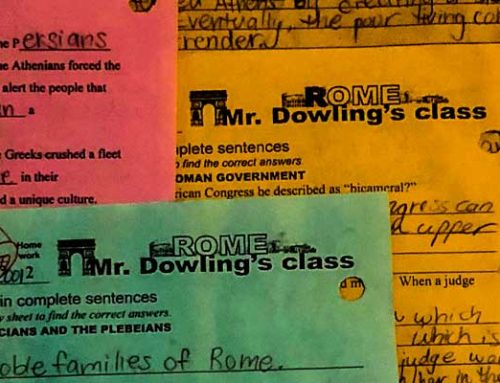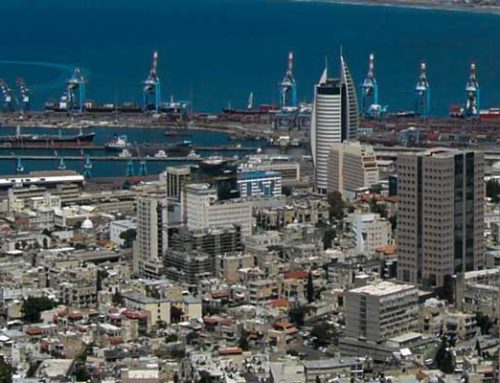The Suez Canal is one of the most important waterways in the world. The 101-mile canal connects the Mediterranean Sea to the Red Sea. The Suez Canal is often called the “crossroads to Europe, Africa, and Asia” because the route is used to transport goods to and from all three continents.
The idea of connecting the Mediterranean Sea to the Red Sea is as old as the pharaohs. There is evidence of a canal constructed about 1850BCE, but desert winds blew in and clogged the canal. About 150 years ago, Great Britain had a thriving trade with India, but without a canal, British ships had to make a long journey around the entire continent of Africa to trade with India. A canal through the Isthmus of Suez would cut the journey from Great Britain to India by 6,000 miles. An isthmus is a narrow strip connecting two larger pieces of land.
A French company led by Ferdinand deLesseps made a deal with Egypt to build the Suez Canal. After ten years of work, the canal opened in 1869. The Egyptian ruler, Ismail, celebrated the opening of the Suez Canal by building a huge palace in Cairo. Ismail treated royalty from around the world to a celebration in honor of the new canal. The heavy spending for the celebration came at a time when the price of Egyptian cotton plunged. Egypt had gone into debt to pay for the Suez Canal. Ismail took out loans from European banks, but he was unable to repay the loans. Consequently, Egypt was forced to sell its share of the Suez Canal to Great Britain.
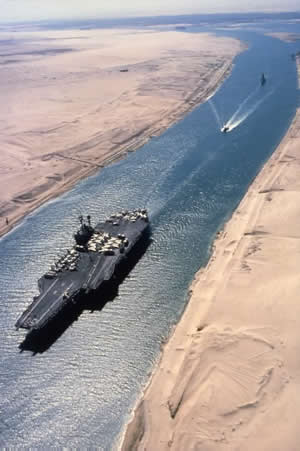
Suez_Canal
The Suez Can cuts the journey from Great Britain to India by 6,000 miles.
The Suez Canal made it easier to trade with faraway nations. The canal also made it possible for European armies to colonize East Africa. In 1936, the British stationed soldiers along the Suez Canal to protect their investment. The canal became very profitable for the British, but many Egyptians were angry because the British did not share the profits of the canal with them.
In 1956, Egyptian President Gamal Abdel Nasser planned to build a great dam to control the annual flooding of the Nile River. Nasser asked the United States and Great Britain for financial assistance. When the two powerful nations refused, Nasser seized the Suez Canal and declared it to be the property of the Egyptian people. Britain, France, and Israel invaded Egypt. World War Two ended a decade earlier, but many feared the Suez Crisis would lead to another World War. A third world war might be even more dangerous than the previous wars because, by 1956, scientists had discovered how to use nuclear weapons. Several nations voted to authorize the United Nations to send peacekeeping forces to the Suez and to call for Britain, France, and Israel to leave the region. Egypt gained control of the canal, but the waterway remained closed for many months because of damage inflicted by the war.
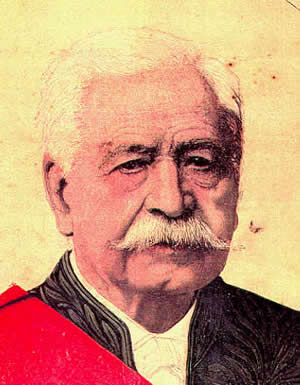
Ferdinand_deLesseps
Ferdinand deLesseps (1805 – 1894) developed the Suez Canal. When completed in 1869, the Suez Canal joined the Mediterranean and Red Seas, substantially reducing sailing distances and times between the West and the East.
The Suez Canal closed again during a 1967 war with Israel. Fourteen ships passing through the canal were forced to anchor at a lake in the middle of the canal. The canal did not reopen for international trade until 1975, meaning some of the ships were stranded in the Suez Canal for more than eight years. Egypt continues to control the Suez Canal, but now international treaties assure that the canal may be used “in time of war as in time of peace, by every vessel of commerce or of war, without distinction of flag.”
Resources
Download this lesson as Microsoft Word file or as an Adobe Acrobat file.
Listen as Mr. Dowling reads this lesson.
Mr. Donn has an excellent website that includes a section on the Middle East and North Africa.
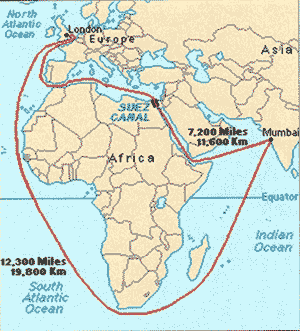
suez-map
The Suez Canal shortened the journey from London to Mumbai by more than 5,000 miles.

